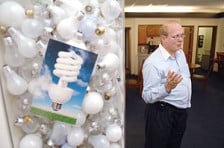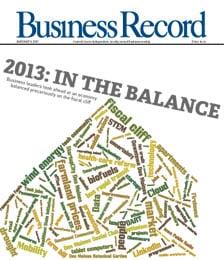Energy efficiency grants begin flowing to Iowa

.floatimg-left-hort { float:left; } .floatimg-left-caption-hort { float:left; margin-bottom:10px; width:300px; margin-right:10px; clear:left;} .floatimg-left-vert { float:left; margin-top:10px; margin-right:15px; width:200px;} .floatimg-left-caption-vert { float:left; margin-right:10px; margin-bottom:10px; font-size: 12px; width:200px;} .floatimg-right-hort { float:right; margin-top:10px; margin-left:10px; margin-bottom:10px; width: 300px;} .floatimg-right-caption-hort { float:left; margin-right:10px; margin-bottom:10px; width: 300px; font-size: 12px; } .floatimg-right-vert { float:right; margin-top:10px; margin-left:10px; margin-bottom:10px; width: 200px;} .floatimg-right-caption-vert { float:left; margin-right:10px; margin-bottom:10px; width: 200px; font-size: 12px; } .floatimgright-sidebar { float:right; margin-top:10px; margin-left:10px; margin-bottom:10px; width: 200px; border-top-style: double; border-top-color: black; border-bottom-style: double; border-bottom-color: black;} .floatimgright-sidebar p { line-height: 115%; text-indent: 10px; } .floatimgright-sidebar h4 { font-variant:small-caps; } .pullquote { float:right; margin-top:10px; margin-left:10px; margin-bottom:10px; width: 150px; background: url(http://www.dmbusinessdaily.com/DAILY/editorial/extras/closequote.gif) no-repeat bottom right !important ; line-height: 150%; font-size: 125%; border-top: 1px solid; border-bottom: 1px solid;} .floatvidleft { float:left; margin-bottom:10px; width:325px; margin-right:10px; clear:left;} .floatvidright { float:right; margin-bottom:10px; width:325px; margin-right:10px; clear:left;}
If it were incorporated as a city, Sun Prairie Apartments would have a larger population than about 90 percent of Iowa towns, with about 3,000 residents. Already one of the most energy-efficient properties in the state, Sun Prairie will become even greener this year by investing hundreds of thousands of dollars in energy-saving upgrades as part of a statewide demonstration project.
Professional Property Management Inc., which manages the complex, last month was awarded a $250,000 State Energy Program grant. The Ames-based company will combine that with its own investment of $576,000 to install state-of-the-art boilers, energy-efficient front-loading washing machines, high-efficiency water heaters and other money-saving measures.
The property management company is among 62 organizations across the state that will receive $9.36 million in federal economic stimulus money distributed by the Iowa Office of Energy Independence (OEI). The projects range from installing photovoltaic cells on rooftops and wind turbines on college campuses to replacing roofs, heating systems and lighting in aging buildings with more energy-efficient alternatives.
After all the projects have been completed, the annual savings will be equivalent to the amount of energy needed to power 5,000 Iowa households for a year, said Roya Stanley, the OEI’s executive director. In monetary terms, that means an annual savings of approximately $4.7 million in energy costs.
But that’s just the tip of the transformer.
The agency has through Sept. 30 to commit an estimated $50 million it expects to receive in stimulus funding for energy-efficiency projects. Stanley said her office expects to receive a second round of funding, approximately $24 million, later this month.
“We’re moving forward quickly and at a good pace as we’ve received the money from the federal government and have gotten more clarity and instructions on how to use it,” she said.
The OEI received 226 applications for the initial round of funding, Stanley said, so she expects many organizations that didn’t receive funding will re-apply for the second round. Generally, the projects that leveraged the greatest amount of private dollars in relation to federal money received the largest grants, she said.
Among the organizations that will benefit from the funding is the World Food Prize Foundation, which received a $500,000 grant. The foundation will add that amount to more than $1.7 million it already planned to spend to upgrade the former Des Moines Public Library building into an energy-efficient home for the World Food Prize Hall of Laureates.
Another historic property, the Hotel Fort Des Moines, will be retrofitted with modern mechanical systems, roofing and windows as part of a planned $55 million renovation project. The hotel’s owner, Principiant Hotel Co. LC, has been awarded $750,000, which it will match with $1.16 million toward the cost of installing all new heating, ventilation and air conditioning, water heaters, roofing and windows in the building.
“Basically we’re taking a 1919 building and redeveloping it as a modern structure, and much of that is modern energy infrastructure,” said Paul Rottenberg, president of Orchestrate Management & Associates, which manages the building. The energy grant is “certainly a great part of the sources, particularly in lending environments where it’s difficult to put a deal together,” he said. Among the private sources of matching funds for the energy grant is MidAmerican Energy Co., which is providing incentive funding based on exceeding existing energy-efficiency standards.
Keith Denner, who founded Professional Property Management 37 years ago, has a long track record for designing and managing energy-efficient, cost-effective rental properties. Sun Prairie, which was built between 1988 and 2003, has energy-saving features such as extra-thick eight-inch walls, high-efficiency boilers and insulating thermal blinds on all windows to seal out heat or cold. Three retention ponds enable the property to use rainwater runoff for the lawn sprinkler system.
During the past year, Denner had all 60,000 of the complex’s conventional light bulbs changed out with energy-saving compact fluorescent bulbs, which he estimated will save tenants more than $250,000 per year in electricity costs.
The 1,073-unit complex, which Denner said is the largest between Chicago and Denver, has received national, state and local awards for its energy efficiency, “and this project will push us to even higher levels,” Denner said. “We’ll do some things that aren’t commonly being done, either in existing complexes or those under construction.”
The demonstration project calls for a number of equipment upgrades, including replacing some of the buildings’ 80-percent-efficient boilers with new 93-percent-efficient boilers, installing front-loading washing machines in some of the buildings and solar collectors to heat water. Some toilets will be changed out to models without flappers to determine whether that reduces leaks to save money.
“The goal of the demonstration project is that we can document the savings in an already efficient complex,” Denner said. Other apartment managers have expressed their support for the project to the state because they hope to prove to the owners that energy upgrades would be cost-effective, he said.
Denner said he’s ready to begin bidding the work as soon as the DNR approves the renovation plans. He plans to use local electricians and plumbers, because one of the federal stimulus program’s goals is to create or retain jobs.
From a business perspective, Denner figures that saving $10,000 a year in energy expenses equates to a $125,000 increase in the value of a rental property.
Now, he just has to figure out what do with 60,000 incandescent light bulbs he still has in storage.








